This waterfront redevelopment project is located at 2900 Longteng Avenue, Xuhui District, Shanghai, China. It shows how revitalizing a city’s public agencies can be when they focus on the public good, rather than just on their own organization’s needs.
The of the project was to replace or reuse the old existing structures—and reconnect the city to the waterfront—in order to create new public spaces and revitalizing redevelopment projects, while also providing a new home for the Shui’an Hui public services agency.
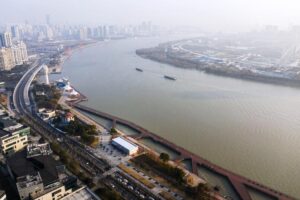 The project aims to modify and soften the current site, as well as to emphasize the connections between the building and open spaces, creating additional public space for the Xuhui riverside area to enhance the quality of life for local residents.
The project aims to modify and soften the current site, as well as to emphasize the connections between the building and open spaces, creating additional public space for the Xuhui riverside area to enhance the quality of life for local residents.
The client (Shui’an Hui) wanted to maintain the original building area and the three differentiated spaces in terms of this regeneration project, energizing existing forgotten spaces and redeveloping more associated functions, as well as the surroundings, to improve the site’s accessibility and the citizens’ everyday life.
Here’s how the architects at Studio TM describe their approach to revitalizing the site:
According to the site investigation and our observations and understandings of ordinary everyday life, we conclude three major issues for this project:
- Based on the flood-control standards, the original site is enclosed by glass barriers, being separated from the riverside trail. The only entrance, also the exit, is on the western side of the site with a considerable height difference, making the site and associated building inaccessible;
- The two corridors on the western and eastern sides of the public restroom are too narrow to use. Also, the current spaces make smells and flow two negative elements for the adjacent public service areas; and
- There are three different functional spaces enveloped in the original building – a 142-square-meter public service space on the north, a public restroom in the middle together with a southern substation for about 190 square meters.
Combining the client’s demands with these three major issues, we have developed three associated design approaches for this project to adjust the negative influences of the current site upon the dynamic riverside area, making it closer to the public everyday life and creating positive impacts for following usages of the site.
Thus, the building was in a hybrid form and even messed before this project.
Soften the Site and Modify the Circulations.
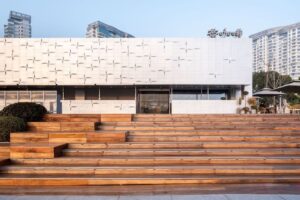 Paired with the management requirements of municipal facilities, the project opens part of the eastern enclosed barriers with the maintenance of original flood-control elevation, especially those right to the northern public service space, re-connecting the two separated circulations at two different levels.
Paired with the management requirements of municipal facilities, the project opens part of the eastern enclosed barriers with the maintenance of original flood-control elevation, especially those right to the northern public service space, re-connecting the two separated circulations at two different levels.
Also, the project lifts the whole site to make it more accessible in terms of its original western entrance/exit. Therefore, the previously stuck public circulations can flow throughout both the site itself and its surroundings.
Citizens have more flexibility, and more site-based functional demands could be satisfied, as well as the northern public service space. From this point of view, the regenerated site is able to meet a variety of public socio-cultural scenes.
Re-organize the Building and Develop More Public Use.
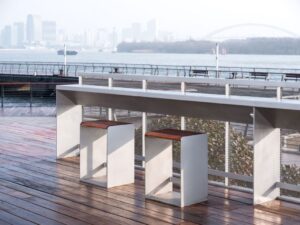 The project re-organizes the existing two narrowed corridors, moving the western one to the east for a combined wider semi-public corridor without changing the original building area to facing the Huangpu River, but solving the two negative spaces.
The project re-organizes the existing two narrowed corridors, moving the western one to the east for a combined wider semi-public corridor without changing the original building area to facing the Huangpu River, but solving the two negative spaces.
Accordingly, the wider corridor could not only make the circulation more efficient but also meet the needs of more ordinary everyday life.
Noting that more and more people will be visiting this site, the project also re-organizes the middle public restroom. The semi-corridor is equipped with movable panels to weaken the boundary between interiors and exteriors, and also to provide the public with sightseeing frames to enjoy the great landscape of the Huangpu River.
Additionally, the project replaces the glass barriers with metal-perforated mesh panels and adjacent stools and mesa side tables for the public to rest, chat, and enjoy the cool wind and fantastic sceneries.
Abstract Expressions and the Long-lost Vitality.
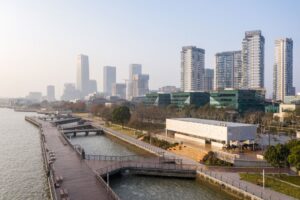 The project redesigns the facade of the existing building to bring the three distinctive languages into one. With the existing outer structures and the development consideration of the Xuhui Riverside Area in general, the project envelops the three volumes with an abstract and de-symbolized facade to make the building more recognizable, thus, bringing back more visitors and the associated long-lost vitality.
The project redesigns the facade of the existing building to bring the three distinctive languages into one. With the existing outer structures and the development consideration of the Xuhui Riverside Area in general, the project envelops the three volumes with an abstract and de-symbolized facade to make the building more recognizable, thus, bringing back more visitors and the associated long-lost vitality.
In addition, the abstract pattern language and the reasonable curve make the building a breath one and the site a vital public space. At night, the particular lighting design distinguishes the building with the help of its facade patterns.
For this project, in addition to the physical architectural spaces, we pay more attention to the spatial-related activities and associated ordinary everyday life in terms of the abstract and de-symbolic context of the Xuhui Riverside Area.
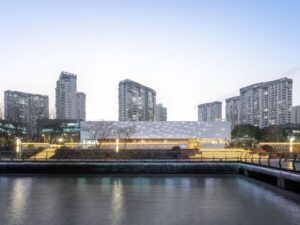 The key principle that we hold for this project is how to soften the existing negative site to make it serve the public’s ordinary everyday life.
The key principle that we hold for this project is how to soften the existing negative site to make it serve the public’s ordinary everyday life.
In conclusion, the regenerated project has developed a continuous sense of publicity, starting from the more accessible western entrance/exit, to the semi-public corridor, to the partially opened metal-perforated mesh panels, finally to the wooden steps which connect with the riverside trail.
Accordingly, our design eliminates the negative influences that the existing site made upon the dynamic riverside space, bringing diverse ordinary everyday life back to the public and providing the Xuhui riverside public opening space developments and the Shui’an Hui public services with vigor and vitality.
All photographs are by Fangfang Tian.

